通过热解实现烟蒂废物的可持续增值:深入了解热解产物以及热解炭随后去除水体重金属的情况
IF 4.1
2区 工程技术
Q2 ENGINEERING, CHEMICAL
引用次数: 0
摘要
在这项研究中,利用 Pyro/GC-MS 和缓慢热解实验,在较宽的温度范围(400-700 °C)内对烟蒂(CB)废料进行了热解。使用 TGA、元素分析、表面积和孔隙率分析、SEM-EDS、XRD 和 FT-IR 对原料和焦炭产品进行了广泛研究,随后测试了它们从水溶液中去除 Ni (II) 和 Cu (II) 的能力。Pyro/GC-MS 分析表明,其中存在多种有用的化合物,包括酸、酯和碳氢化合物。炭产量从 26.6% 到 20.1%不等,碳含量从 65.3% 到 60.8%不等。在中温(500-600 °C)下生产的炭具有高多孔性,比表面积为 272.9-270.8 m2/g。重金属吸附研究表明,CB 500 °C 的吸附容量最高,为 13.8 mg/g,镍去除率为 53.4%;CB 600 °C 的吸附容量最高,为 23.4 mg/g,铜去除率为 94.7%。本文章由计算机程序翻译,如有差异,请以英文原文为准。


Sustainable valorisation of cigarette butts waste through pyrolysis: An insight into the pyrolytic products and subsequent aqueous heavy metals removal by pyrolytic char
In this study, cigarette butts (CB) waste was pyrolyzed over a wide temperature range (400–700 °C) using Pyro/GC–MS and slow pyrolysis experiments. The feedstock and char products were extensively investigated using TGA, elemental analysis, surface area and porosity analysis, SEM-EDS, XRD, and FT-IR, and subsequently tested for their ability to remove Ni (II) and Cu (II) from aqueous solutions. The Pyro/GC–MS analysis revealed the presence of several useful compounds including acids, esters and hydrocarbons. Char yields ranged from 26.6 to 20.1 wt%, and carbon contents varied from 65.3 to 60.8 wt%. The chars produced at medium temperatures (500-600 °C) were highly porous, with a specific surface area of 272.9–270.8 m2/g. The heavy metal adsorption studies revealed that CB 500 °C had the highest adsorption capacity of 13.8 mg/g with 53.4 % nickel removal, while CB 600 °C had the highest adsorption capacity of 23.4 mg/g with 94.7 % copper removal.
求助全文
通过发布文献求助,成功后即可免费获取论文全文。
去求助
来源期刊

Chemical Engineering Science
工程技术-工程:化工
CiteScore
7.50
自引率
8.50%
发文量
1025
审稿时长
50 days
期刊介绍:
Chemical engineering enables the transformation of natural resources and energy into useful products for society. It draws on and applies natural sciences, mathematics and economics, and has developed fundamental engineering science that underpins the discipline.
Chemical Engineering Science (CES) has been publishing papers on the fundamentals of chemical engineering since 1951. CES is the platform where the most significant advances in the discipline have ever since been published. Chemical Engineering Science has accompanied and sustained chemical engineering through its development into the vibrant and broad scientific discipline it is today.
 求助内容:
求助内容: 应助结果提醒方式:
应助结果提醒方式:


